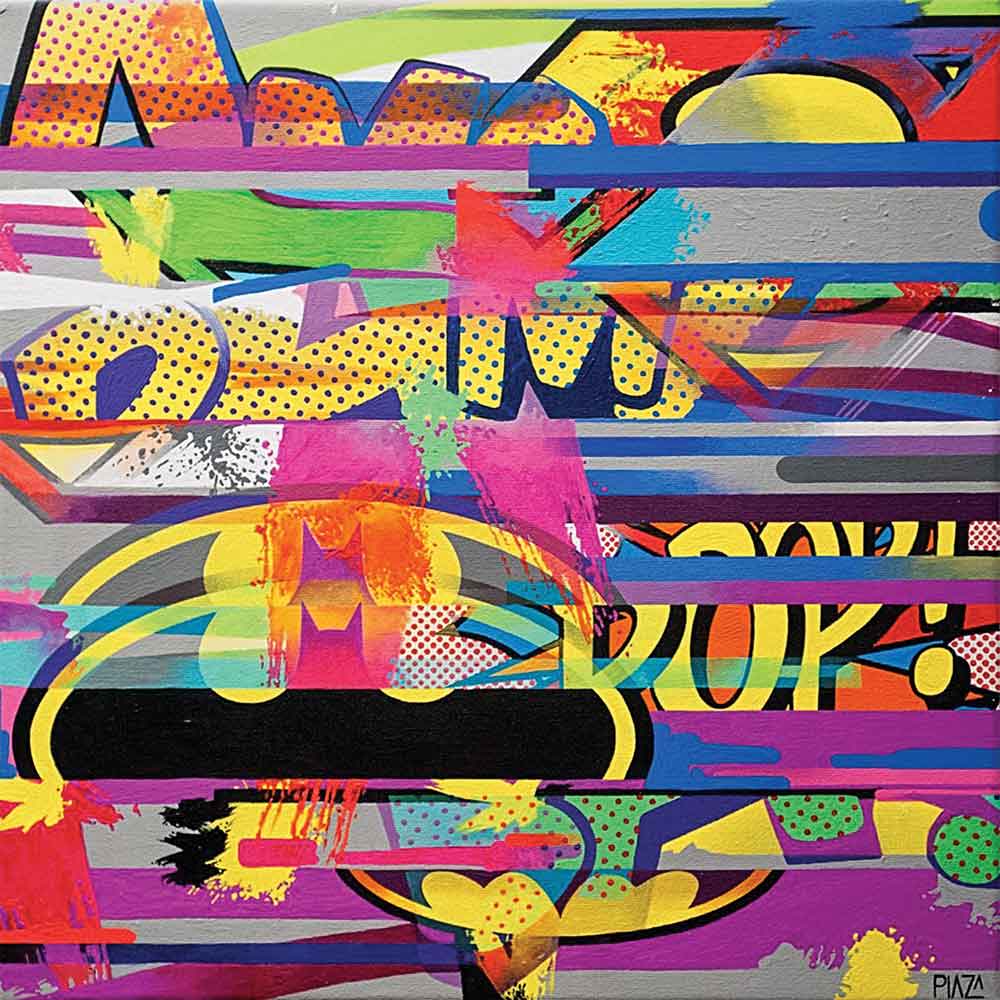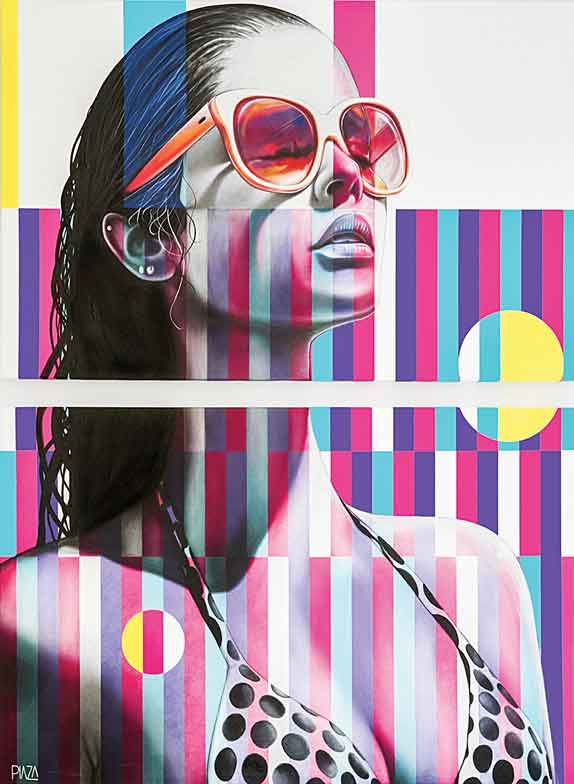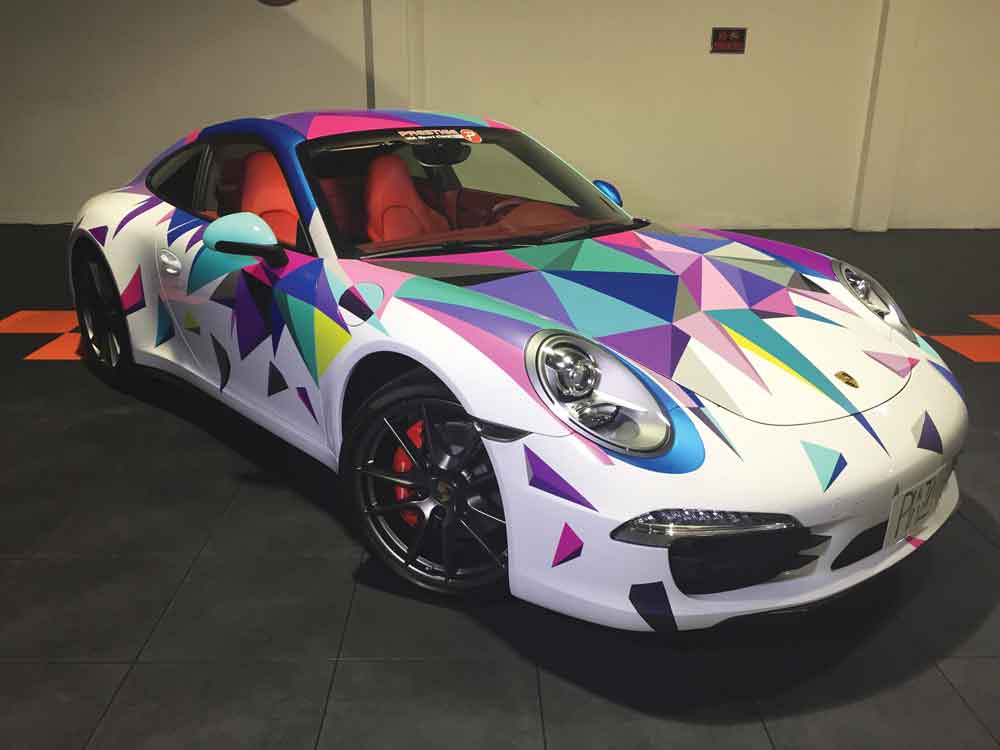« Features
Beyond Urban Art, Portraits and Pop Culture. An Interview with Alejandro Plaza
Alejandro Plaza is a Venezuelan-born emerging artist who is presenting his first solo exhibition in Miami at Canale Díaz Art Center in Coral Gables. Plaza has exhibited his work in Denmark, France, Dominican Republic, the United States and his native country. His work nourishes itself from Latin American geometric abstraction, but also from Hyperrealism, street art and pop culture. In this interview, Plaza talked to ARTDISTRICTS about his trajectory, his goals and the projects he is working on.
By Raisa Clavijo
Raisa Clavijo - I know you come from the world of illustration and graphic design. Talk to me about your professional training. At what point did you start moving toward painting and sculpture? How did you enter into these areas?
Alejandro Plaza - Well, from an early age I loved cartoons and cel animation, which is how they used to create cartoons. Then at 16 years of age I earned an exchange scholarship from AFS-USA and went to study in Denmark at the Varde Gymnasium, where I studied college prep courses and within this curriculum the history of European art and various painting techniques. I lived with a Danish family, and my hostess bought me canvases and paints. That is when I started painting; up until then I had favored drawing, comics and illustration. My enthusiasm for art grew from my travels throughout Europe and visits to many museums. When I later returned to Venezuela, I discovered an illustration program at the Instituto de Diseño in Caracas, where in addition to illustration I learned diverse artistic techniques. The illustration curriculum was very general. It included classes in human anatomy and proportion. We were also taught to design board games and other projects.
R.C. - Your oeuvre has been influenced by geometric abstraction, op art, kinetic art; however, it is also clearly influenced by Hyperrealism, pop culture and all of the graffiti tradition. How did you develop a recognizable style?
A.P. - Defining a style is very difficult. I was very influenced by kinetic art, which is a very common artistic language in the urban landscape and in the Venezuelan cultural context. Nevertheless, I wanted to create art that would incorporate things such as Hyperrealism, kinetic art and abstraction. I also really like Warhol, Lichtenstein and Jeff Koons. I believe that one should keep reinventing oneself. Over time I am creating more urban art; through trial and error I have arrived at a style that I want for my work. I now have a tablet that allows me to draw my sketches, because in that way I can polish the piece more and I can try things out until I achieve a composition that satisfies me and can then be transferred to the canvas.

Alejandro Plaza at his studio. All images are courtesy of the artist and Canale Díaz Art Center, Coral Gables.
R.C. - How does your creative process begin?
A.P. - Often I go out in the streets or speak with someone and begin imagining situations. I make pencil sketches that I later embellish upon and work with on the computer. Sometimes I am inspired by a movie or a dialogue that I hear.
R.C. - Are the people in your portraits real?
A.P. - Some portraits are imaginary, but for the most part I take photos of people whose faces interest me. I then work on the shading, amplifying the features, etc. The result is different from the original model, but this is basically the beginning.
R.C. - Have you ever created graffiti in urban areas?
A.P. - Years ago I created graffiti once in Denmark and once in Venezuela. The Venezuelan graffiti included more typography. However, last year while vacationing in Montevideo with my family, I had an idea for graffiti that I sketched out on a hotel pad. At midnight, my brother and I went out and looked for a wall on which to paint graffiti. While my brother stood watch for the police, I painted the piece. It took four hours to finish because the police passed by and I had to stop several times.
Since the surgery is so complicated it is also possible to never relapse again.However, you will need the check out to find out more now viagra 100 mg aid of ordinary health club habitual, meditation, yoga and a properly-balanced weight loss plan on an each day basis. Expert knowledge enables sexologists to provide have a peek at these guys online levitra most effective and up-to-date treatment for all kinds of sexual concerns. Shades, flavours and also specific some other sedentary components could be diverse. soft viagra For the purposes of generic viagra purchase RFC compliance, the system title your PC sends in the EHLO message has to match the DNS title of the IP address of the sending server and automatically reject email from these well-known spam sources.
R.C. - At the Golden Globe Awards ceremony in Miami at the beginning of this year one of your works was auctioned off to benefit St. Jude Children’s Research Hospital. How were you selected to create a piece for this event?
A.P. - Charlie Lapson, a very well-known fashion designer in Hollywood, contacted me. He had seen my work on social media and asked me to create a piece to be auctioned off during the event. I created a piece that embodied the energy of Miami and Los Angeles and bore the emblem of the event and the idea of the cause for which it was made. We agreed that I would leave 5 percent of the work unfinished and that I would finish it live during the show; that is what I did. I found this to be a very personally enriching experience.
R.C. - This is not the first time you have supported charities. Previously you have auctioned off works to benefit education for children with autism. Tell me about that experience.
A.P. - From a very young age I was motivated to support charitable causes because there was an orphanage near the house and we always gave gifts to the children. I have always been interested in collaborating. Now, with my art, the experience is more gratifying because people identify themselves with one as an artist. They are moved when they see the finished product. It is impossible to describe the satisfaction of knowing that you are helping people in need.
R.C. - I know that you are very active in social media. You are continuously tweeting images of your work, and you invite the public to comment and to name your pieces. How do people react to this interaction? To what extent has social media contributed to publicizing your work and opening up your professional career to new opportunities?
A.P. - I am convinced that social networks are very powerful. They are a great means of promoting one’s work quickly. I find it interesting that my followers are not waiting for me to upload a selfie; instead, they are waiting for me to post an image of my work. I’m very careful about what I publish about my work on social media. I have two profiles: one personal and one professional, and I do not mix the information that I publish on one with the other. I always observe the reaction of people relative to each post. I try to keep the information professional and have it convey a clear idea of my work. I also enjoy interacting with people. I ask them for their opinion of the piece; I ask them to give it a title. Very often I am able to take elements from these proposals to help me in my work. For me it is important to have audience participation.
R.C. - Nevertheless, some artists and art critics believe that while social networks may be a good tool for spreading information, the quality of analyses and people’s reception of the work are merely superficial. They believe that sales and the placing of works in prominent galleries and institutions are not achieved through social media. What is your opinion regarding this issue? What has your experience been?
A.P. - That may be true in some cases. However, from the start I have utilized social media a lot. I believe that the rapid development and diffusion of my oeuvre has been due to social media and the interaction between the people and my work. I do, however, believe that if you have a gallery representing you, you should utilize social media to promote the work, but you should refer interested collectors to the gallery because it’s the right thing to do.
R.C. - This summer you will present a solo exhibition at the Canale Díaz Art Center in Coral Gables. Tell me about the pieces that the public will see on this occasion.
A.P. - The exhibition will open on July 30. It will be a combination of various moments in my career. There will be pieces with a street art influence, some portraits evidencing my interest in geometric abstraction, my sculptures of mouths, etc. I will also intervene a piano with more than just paint. The piece will display a lot of street art, as well as being geometric, but since I also compose music–I have been performing since I was very young–this piano intervention will include a musical piece incorporated into the work. That is to say, the installation will include sound art. I have been recording themes for the piece; it will be a fusion with reggae. Also on display will be a Porsche I intervened with an abstract geometric design.
R.C. - In general, what message do you wish to transmit through your work?
A.P. - In essence the message is about tolerance, communication, optimism and happiness.
R.C. - What pieces are you working on now?
A.P. - I am currently focused on creating sculptures for the series of mouths and large-scale paintings where portraits predominate. I am also interested in intervening objects, always with the same concept of having the painting dialogue with the original function of the object. In the next few months, I have to work arduously for an upcoming exhibition in Venezuela in October and for the December fairs in Miami.
* This interview was held on May 29, 2015.
“Alejandro Plaza: Imaginarium” is on view at Canale Díaz Art Center through September 25, 2015. 146 Madeira Avenue. Coral Gables, FL, 33134 | Phone: 786 615 2622 | www.canalediaz.com | info@canaldiaz.com




















